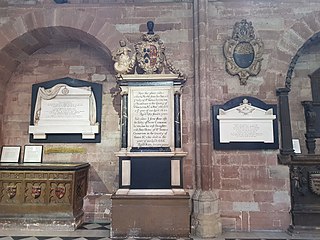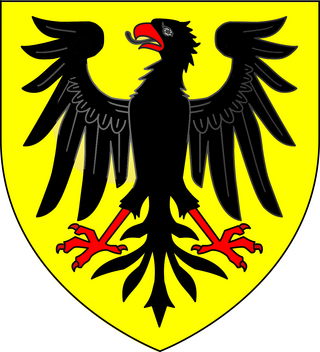

Baron Lyttelton is a title that has been created once in Peerage of England and twice in Peerage of Great Britain, both times for members of the Lyttelton family. Since 1889 the title has been a subsidiary title of the viscountcy of Cobham.


Baron Lyttelton is a title that has been created once in Peerage of England and twice in Peerage of Great Britain, both times for members of the Lyttelton family. Since 1889 the title has been a subsidiary title of the viscountcy of Cobham.
Baron Lyttelton, of Mounslow in the County of Shropshire, was a title in the Peerage of England. It was created on 18 February 1641 for Edward Littleton, Chief Justice of North Wales. [1] On his death the barony became extinct.
The Lyttelton barons of Frankley belong to the Frankley and Hagley branch of the extended Littleton/Lyttelton family.
In 1618, Thomas Lyttelton (1593–1650), owner of estates in Frankley, Halesowen, Hagley and Upper Arley, was created Baronet of Frankley, in the County of Worcester, in the Baronetage of England. [2] He later represented Worcestershire in the House of Commons. His son, the second Baronet, sat as Member of Parliament for Lichfield. On his death the titles passed to his younger brother, the third Baronet, He represented Bewdley in Parliament. He was succeeded by his son, the fourth Baronet. He was Member of Parliament for Worcester and Camelford. Lyttelton married Christian, daughter of Sir Richard Temple, 3rd Baronet, and sister of Richard Temple, 1st Viscount Cobham, and Hester Grenville, 1st Countess Temple. The viscountcy of Cobham and its junior title the barony of Cobham were created with remainder, failing male issue, to (1) Lord Cobham's eldest sister Hester Grenville (who succeeded as second Viscountess in 1749 and was created Earl Temple in 1750) and the heirs male of her body and (2) to his third sister Christian, with remainder to the heirs male of her body.
Lyttelton was succeeded by his eldest son, the fifth Baronet, who was a prominent politician. In 1755 he was created Baron Lyttelton, of Frankley in the County of Worcester, in the Peerage of Great Britain. He was succeeded by his son, the second Baron. He briefly represented Bewdley in the House of Commons. Lord Lyttelton had no legitimate issue and on his death in 1779 the barony became extinct. However, he was succeeded in the baronetcy by his uncle, the seventh Baronet. He also represented Bewdley in Parliament and served as Governor of South Carolina and of Jamaica. In 1776, three years before he succeeded in the baronetcy, he was created Baron Westcote, of Balamere in the County of Longford, in the Peerage of Ireland. In 1794 he was further created Baron Lyttelton, of Frankley in the County of Worcester, in the Peerage of Great Britain. His eldest son, the second Baron, also sat as Member of Parliament for Bewdley. He was succeeded by his half-brother, the third Baron. He represented Worcestershire in the House of Commons and also served as Lord Lieutenant of Worcestershire. His son, the fourth Baron, was briefly Under-Secretary of State for War and the Colonies in 1846 under Sir Robert Peel and also served as Lord Lieutenant of Worcestershire. On his death, the titles passed to his son, the fifth Baron. In 1889 he succeeded his distant relative Richard Temple-Nugent-Brydges-Chandos-Grenville, 3rd Duke of Buckingham and Chandos, as eighth Baron and Viscount Cobham, according to the aforementioned special remainder in the letters patent.
Since 1889 the holders of the Lyttelton titles of 1618 and 1794 have chosen to use the style of Viscount Cobham (see there for further history).

For further succession see Viscount Cobham.
| Family tree of the Duke of Buckingham and Chandos, Marquess of Buckingham, Marquess of Chandos, Viscount Cobham, Earl Temple, Earl Temple of Stowe, Baron Cobham, Baron Grenville, Baron Lyttelton, Baron Westcote and Temple baronets | |||||||||||||||||||||||||||||||||||||||||||||||||||||||||||||||||||||||||||||||||||||||||||||||||||||||||||||||||||||||||||||||||||||||||||||||||||||||||||||||||||||||||||||||||||||||||||||||||||||||||||||||||||||||||||||||||||||||||||||||||||||||||||||||||||||||||||||||||||||||||||||||||||||||||||||||||||||||||||||||||||||||||||||||||||||||||||||||||||||||||||||||||||||||||||||||||||||||||||||||||||||||||||||||||||||||||||||||||||||||||||||||||||||||||||||||||||||||||||||||||||||||||||||||||||||||||||||||||||||||||||||||||||||||||||||||||||||||||||||||||||||||||||||||||||||||||||||||||||||||||||||||||||||||||||||||||||||||||||||||||||||||||||||||||||||||||||||||||||||||||||||||||||||||||||||||||||||||||||||||||||||||||||||||||||||||||||||||||||||||||||||||||||||||||||||||||||||||||||||||||||||||||||||||||||||||||||||||||||||||||||||||||||||||||||||||||||||||||||||||||||||||||||||||||||||||||||||||||||||||||||||||||||||||||||||||||||||||||||||||||||||||||||||||||||||||||||||||||||||||
|---|---|---|---|---|---|---|---|---|---|---|---|---|---|---|---|---|---|---|---|---|---|---|---|---|---|---|---|---|---|---|---|---|---|---|---|---|---|---|---|---|---|---|---|---|---|---|---|---|---|---|---|---|---|---|---|---|---|---|---|---|---|---|---|---|---|---|---|---|---|---|---|---|---|---|---|---|---|---|---|---|---|---|---|---|---|---|---|---|---|---|---|---|---|---|---|---|---|---|---|---|---|---|---|---|---|---|---|---|---|---|---|---|---|---|---|---|---|---|---|---|---|---|---|---|---|---|---|---|---|---|---|---|---|---|---|---|---|---|---|---|---|---|---|---|---|---|---|---|---|---|---|---|---|---|---|---|---|---|---|---|---|---|---|---|---|---|---|---|---|---|---|---|---|---|---|---|---|---|---|---|---|---|---|---|---|---|---|---|---|---|---|---|---|---|---|---|---|---|---|---|---|---|---|---|---|---|---|---|---|---|---|---|---|---|---|---|---|---|---|---|---|---|---|---|---|---|---|---|---|---|---|---|---|---|---|---|---|---|---|---|---|---|---|---|---|---|---|---|---|---|---|---|---|---|---|---|---|---|---|---|---|---|---|---|---|---|---|---|---|---|---|---|---|---|---|---|---|---|---|---|---|---|---|---|---|---|---|---|---|---|---|---|---|---|---|---|---|---|---|---|---|---|---|---|---|---|---|---|---|---|---|---|---|---|---|---|---|---|---|---|---|---|---|---|---|---|---|---|---|---|---|---|---|---|---|---|---|---|---|---|---|---|---|---|---|---|---|---|---|---|---|---|---|---|---|---|---|---|---|---|---|---|---|---|---|---|---|---|---|---|---|---|---|---|---|---|---|---|---|---|---|---|---|---|---|---|---|---|---|---|---|---|---|---|---|---|---|---|---|---|---|---|---|---|---|---|---|---|---|---|---|---|---|---|---|---|---|---|---|---|---|---|---|---|---|---|---|---|---|---|---|---|---|---|---|---|---|---|---|---|---|---|---|---|---|---|---|---|---|---|---|---|---|---|---|---|---|---|---|---|---|---|---|---|---|---|---|---|---|---|---|---|---|---|---|---|---|---|---|---|---|---|---|---|---|---|---|---|---|---|---|---|---|---|---|---|---|---|---|---|---|---|---|---|---|---|---|---|---|---|---|---|---|---|---|---|---|---|---|---|---|---|---|---|---|---|---|---|---|---|---|---|---|---|---|---|---|---|---|---|---|---|---|---|---|---|---|---|---|---|---|---|---|---|---|---|---|---|---|---|---|---|---|---|---|---|---|---|---|---|---|---|---|---|---|---|---|---|---|---|---|---|---|---|---|---|---|---|---|---|---|---|---|---|---|---|---|---|---|---|---|---|---|---|---|---|---|---|---|---|---|---|---|---|---|---|---|---|---|---|---|---|---|---|---|---|---|---|---|---|---|---|---|---|---|---|---|---|---|---|---|---|---|---|---|---|---|---|---|---|---|---|---|---|---|---|---|---|---|---|---|---|---|---|---|---|---|---|---|---|---|---|---|---|---|---|---|---|---|---|---|---|---|---|---|---|---|---|---|---|---|---|---|---|---|---|---|---|---|---|---|---|---|---|---|---|---|---|---|---|---|---|---|---|---|---|---|---|---|---|---|---|---|---|---|---|---|---|---|---|---|---|---|---|---|---|---|---|---|---|---|---|---|---|---|---|---|---|---|---|---|---|---|---|---|---|---|---|---|---|---|---|---|---|---|---|---|---|---|---|---|---|---|---|---|---|---|---|---|---|---|---|---|---|---|---|---|---|---|---|---|---|---|---|---|---|---|---|---|---|---|---|---|---|---|---|---|---|---|---|---|---|---|---|---|---|---|---|---|---|---|---|---|---|---|---|---|---|---|---|---|---|---|---|---|---|---|---|---|---|---|---|---|---|---|---|---|---|---|---|---|---|---|---|---|---|---|---|---|---|---|---|---|---|---|---|---|---|---|---|---|---|---|---|---|---|---|---|---|---|---|---|---|---|---|---|---|---|---|---|---|---|---|---|---|---|---|---|---|---|---|---|---|---|---|---|---|---|---|---|---|---|---|---|---|---|---|---|---|---|---|---|---|---|---|---|---|---|---|---|---|---|---|---|---|---|---|---|---|---|---|---|---|---|---|---|---|---|---|---|---|---|---|---|---|---|---|---|---|---|---|---|---|---|---|---|---|---|---|---|---|---|---|---|---|---|---|---|---|---|---|---|---|---|---|---|---|---|---|---|---|---|---|---|---|---|---|---|---|
| |||||||||||||||||||||||||||||||||||||||||||||||||||||||||||||||||||||||||||||||||||||||||||||||||||||||||||||||||||||||||||||||||||||||||||||||||||||||||||||||||||||||||||||||||||||||||||||||||||||||||||||||||||||||||||||||||||||||||||||||||||||||||||||||||||||||||||||||||||||||||||||||||||||||||||||||||||||||||||||||||||||||||||||||||||||||||||||||||||||||||||||||||||||||||||||||||||||||||||||||||||||||||||||||||||||||||||||||||||||||||||||||||||||||||||||||||||||||||||||||||||||||||||||||||||||||||||||||||||||||||||||||||||||||||||||||||||||||||||||||||||||||||||||||||||||||||||||||||||||||||||||||||||||||||||||||||||||||||||||||||||||||||||||||||||||||||||||||||||||||||||||||||||||||||||||||||||||||||||||||||||||||||||||||||||||||||||||||||||||||||||||||||||||||||||||||||||||||||||||||||||||||||||||||||||||||||||||||||||||||||||||||||||||||||||||||||||||||||||||||||||||||||||||||||||||||||||||||||||||||||||||||||||||||||||||||||||||||||||||||||||||||||||||||||||||||||||||||||||||||
Duke of Buckingham, referring to Buckingham, is an extinct title that has been created several times in the peerages of England, Great Britain, and the United Kingdom. There were creations of double dukedoms of Buckingham and Normanby and of Buckingham and Chandos. The last holder of the dukedom died in 1889.

Viscount Cobham is a title in the Peerage of Great Britain that was created in 1718. Owing to its special remainder, the title has passed through several families. Since 1889, it has been held by members of the Lyttelton family.

Viscount Chandos, of Aldershot in the County of Southampton, is a title in the Peerage of the United Kingdom and held by a branch of the Lyttelton family. It was created in 1954 for the businessman and public servant Oliver Lyttelton. He was the son of the politician and sportsman Alfred Lyttelton, eighth son of George Lyttelton, 4th Baron Lyttelton, whose eldest son, the 5th Baron Lyttelton, also succeeded his kinsman The 3rd Duke of Buckingham and Chandos as 8th Viscount Cobham in 1889. As of 2017 the title of Viscount Chandos is held by the first Viscount's grandson, the third Viscount, who succeeded his father in 1980. He lost his seat in the House of Lords after the passing of the House of Lords Act of 1999, which removed the automatic right of hereditary peers to sit in the upper chamber of Parliament. However, in 2000 he was given a life peerage as Baron Lyttelton of Aldershot, of Aldershot in the County of Hampshire, and was thus able to return to the House of Lords, where he now sits on the Labour benches. Lord Chandos is also in remainder to the viscountcy of Cobham and its subsidiary titles the barony of Cobham, the barony of Lyttelton, the barony of Westcote and the baronetcy of Frankley.

Lord Kinloss is a title in the Peerage of Scotland. It was created in 1602 for Edward Bruce, later Master of the Rolls, with remainder to his heirs and assigns whatsoever. In 1604 he was also made Lord Bruce of Kinloss, with remainder to his heirs male, and in 1608 Lord Bruce of Kinloss, with remainder to any of his heirs. He was succeeded by his son, the second Lord, who was killed in a duel in 1613.

Earl Temple of Stowe, in the County of Buckingham, is a title in the Peerage of the United Kingdom. It was created in 1822 for Richard Temple-Nugent-Brydges-Chandos-Grenville, 2nd Marquess of Buckingham, who was created Marquess of Chandos and Duke of Buckingham and Chandos at the same time. In contrast to the Marquessate and Dukedom, which were created with remainder to the heirs male of his body only, the Earldom was created with remainder to (1) the heirs male of his body, failing which to (2) the heirs male of his deceased great-grandmother the 1st Countess Temple, failing which to (3) his granddaughter Lady Anna Grenville and the heirs male of her body, and then to possible younger daughters of Lord Temple and the heirs male of their bodies.

Earl of Dudley, of Dudley Castle in the County of Stafford, is a title that has been created twice in the Peerage of the United Kingdom, both times for members of the Ward family.

Sir Thomas de Littleton or de LyttletonKBSL(c. 1407–23 August 1481) was an English judge, undersheriff, Lord of Tixall Manor, and legal writer from the Lyttelton family. He was also made a Knight of the Bath by King Edward IV.

Sir Thomas Lyttelton, 1st Baronet was an English Royalist officer and politician from the Lyttelton family during the English Civil War.
The Baronetcy of Temple, of Stowe, in the Baronetage of England, was created on the 24th of September 1611 for Thomas Temple, eldest son of John Temple of Stowe, Buckinghamshire. His great-grandson Sir Richard, 4th Baronet, was created Baron Cobham on 19 October 1714, and Viscount Cobham and Baron Cobham on 23 May 1718, the latter with a special remainder, failing his male issue to his sisters and their heirs male. Upon his death on the 13th September 1749, the barony of 1714 became extinct. Both the viscountcy and barony of 1718 passed to his elder sister, and the baronetcy passed to his second cousin once removed William Temple, of Nash House, who became 5th Baronet. On the death of Sir William's nephew Sir Richard Temple, 7th Baronet, on 15 November 1786, the baronetcy became dormant.

Earl Nugent was a title the Peerage of Ireland. It was created on 21 July 1776 for Robert Craggs-Nugent, 1st Viscount Clare, with remainder, failing heirs male of his body, to his son-in-law The 3rd Earl Temple and the heirs male of his body. Craggs-Nugent had already been made Baron Nugent, of Carlanstown in the County of Westmeath, and Viscount Clare, in the Peerage of Ireland on 19 January 1767. He died 13 October 1788, when the barony and viscountcy became extinct, and the earldom, under the terms of the special remainder, passed to his son-in-law, formerly known as Lord Temple, now The 1st Marquess of Buckingham. The earldom remained in his family until the death of The 5th Earl Nugent, also The 3rd Duke of Buckingham and Chandos, on 26 March 1889. See Viscount Cobham for further history of the title. The barony of Nugent was revived in 1800 in favour of his daughter, Mary, Marchioness of Buckingham. See Baron Nugent.

Three baronetcies have been created in the Baronetage of England for members of the Littleton or Lyttelton family. All three lines are descended from Thomas de Littleton, a noted 15th-century jurist. Despite differences in the spelling of the title, the names of all three lines were spelt in many varied ways in the early modern period, without distinction between the different branches of the family. This can be confusing, as the range of forenames in use was very limited.

Charles George Lyttelton, 8th Viscount Cobham, known as The Lord Lyttelton from 1876 to 1889, was a British peer and politician from the Lyttelton family. He was a Liberal Member of Parliament.

John Lyttelton MP JP (1561–1601) was an English politician and member of the Lyttelton family who served as Member of Parliament for Worcestershire during the reign of Queen Elizabeth I.
Sir Henry Lyttelton, 2nd Baronet was an English politician and member of the Lyttelton family. He was a Royalist officer during the English Civil War. After the Restoration, from 1678 to 1679 he sat in the House of Commons.
Sir Charles Lyttelton, 3rd Baronet, of Frankley, in the County of Worcester, MP was one of the early English Governors of Jamaica, an army officer, and Member of Parliament from the Lyttelton family.
Sir Thomas Lyttelton, 4th Baronet, of Frankley, in the County of Worcester, was an English landowner and Whig politician who sat in the House of Commons from 1721 to 1741. He held office as one of the Lords of the Admiralty from 1727 to 1741.

William Henry Lyttelton, 1st Baron Lyttelton MP was a British politician and colonial administrator from the Lyttelton family. He was the youngest son of Sir Thomas Lyttelton, 4th Baronet.

George Fulke Lyttelton, 2nd Baron Lyttelton was an Anglo-Irish peer and politician from the Lyttelton family.

Sir Richard Temple, 3rd Baronet, KB was an English politician who sat in the House of Commons at various times between 1654 and 1697.

The Lyttelton family is a British aristocratic family. Over time, several members of the Lyttelton family were made knights, baronets and peers. Hereditary titles held by the Lyttelton family include the viscountcies of Cobham and Chandos, as well as the Lyttelton barony and Lyttelton baronetcy. Several other members of the family have also risen to prominence, particularly in the field of cricket.